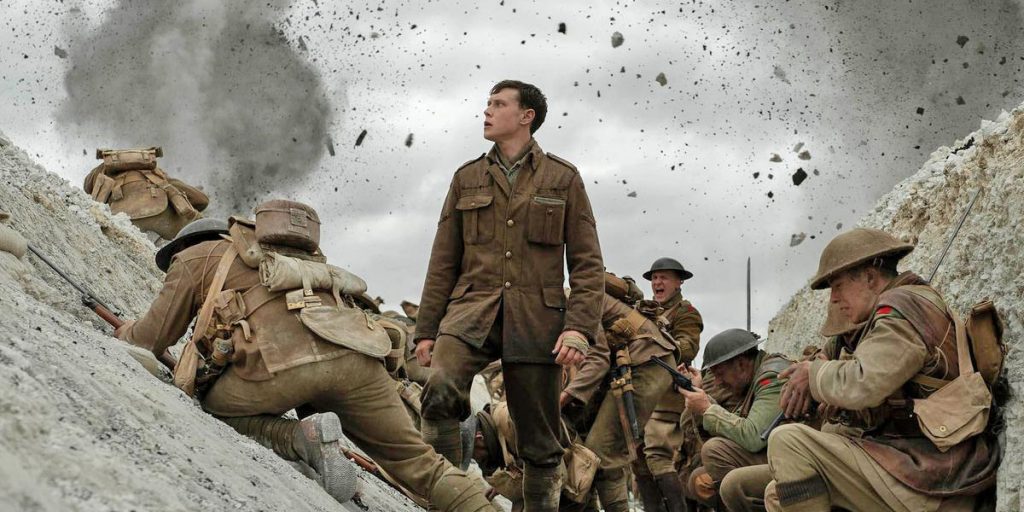1917 is a visual triumph while delivering a fresh perspective on the resilience of the human spirit against the horrors of trench warfare.
War and horror films seem to have a lot in common: both are known for being bloody spectacles creating an uneasy viewing experience, and usually most of the cast won’t make it until the end. A major difference, however, is that war films are much more likely to find critical acclaim and prestige. Enter 1917, Sam Mendes’s already award-winning effort. The film has been released to near universal acclaim and has been nominated for ten Oscars. With the big award night on the horizon, let’s revisit the trenches on the Western Front, shall we?
1917 follows two English soldiers, Lance Corporal William Schofield (George MacKay) and Lance Corporal Thomas Blake (Dean-Charles Chapman), as they race against time to travel through enemy territory to deliver plans that could potentially save 1,600 of their own soldiers. While I would not describe 1917 as a narrative driven experience, the filmmaking itself is masterful, and the stakes, tension, and pacing effectively keeps you invested. You don’t have to be a war-film fan to enjoy this movie, as 1917 does an excellent job separating itself from other films of the genre, and offers much more depth than hyper-patriotic power fantasy.
An aspect of the film that sets it apart right away is its cinematography: cinematographer Roger Deakins frames the film to appear as if it were shot in a single take, as the audience experiences time at the same pace as the characters. Because of this shooting style, 1917 relies more on atmosphere and suspense than it does action and bloodshed. Don’t be surprised if you watch several minutes of the two corporals traversing a single landscape. While its slower pacing might be a deterrent for fans of more action-packed war films like The Dirty Dozen or Saving Private Ryan, the pacing allows for the film to create long sequences of tension, giving you a glimpse into life on the front lines. The only downside is the same issue I have with Hitchcock’s Rope: I spent far too much time closely watching the camera work looking for the places where they were able to cut between takes. Ultimately, however, the single-shot technique works in the film’s favor as you get a sense of being on the front lines with these soldiers, and feel their anxiety with them in real time.

MacKay and Chapman both deliver sharp performances as the corporals, both doing an excellent job of portraying boys barely out of adolescence, not yet ready to be referred to as “men.” It is honestly refreshing to see actors playing soldiers who are (or at least look) as young as the men who fought in the World Wars. I myself have watched a few too many movies where jacked up thirty-somethings try to pass themselves off as fresh-faced college-aged boys. I’m so used to seeing soldiers portrayed by grizzled men who are older than me, to see actors who are actually the age of WWI soldiers is jarring. There are not many other named characters outside of the main duo, but the cast is rounded out by cameos from some famous British faces including Colin Firth, Benedict Cumberbatch, Mark Strong, and Richard Madden. This lack of named characters works to 1917’s benefit as the fleeting and infrequent visits from friendly and familiar faces only reminds us and the characters of how alone they are.
The score, when it is used, is used sparingly. Composer Thomas Newton makes use of long sustained notes to accentuate both tension and action. His implementation of repeated melodies creates an interesting representation of life on the front lines. Melodic themes used during moments of peace will be reused during an action sequence, further punctuating the point that these soldiers are never truly safe from danger.
Where 1917 shines, however, are its brief moments of humanity. As Platoon will remind us, “the first casualty of war is innocence,” and 1917 certainly paints a vivid picture of how death and destruction can mold an impressionable mind. In the film’s quieter sequences, however, the characters will remind the audience that there still remains at least a sliver of humanity through monologues and actions, whether it be Blake’s stories of home, or Schofield offering his own resources to feed a hungry infant. Don’t get me wrong, 1917 is an intense film that does an excellent job portraying the bleakness and despair of World War I. But it reminds us that its characters are still just people, with physical and mental limitations, as well as empathy and humanity.
1917 is now available to watch on digital and on demand, and on DVD and Blu-Ray.

